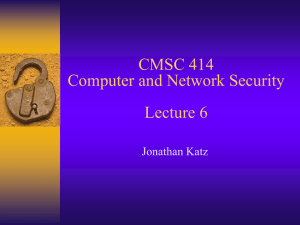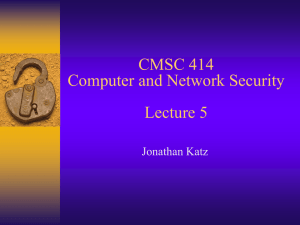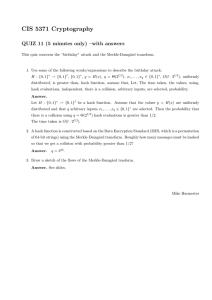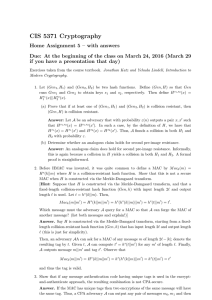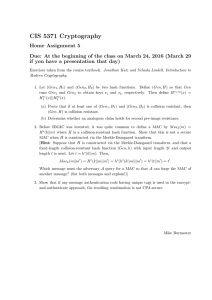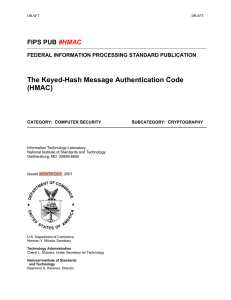CMSC 414 Computer and Network Security Lecture 5 Jonathan Katz
advertisement
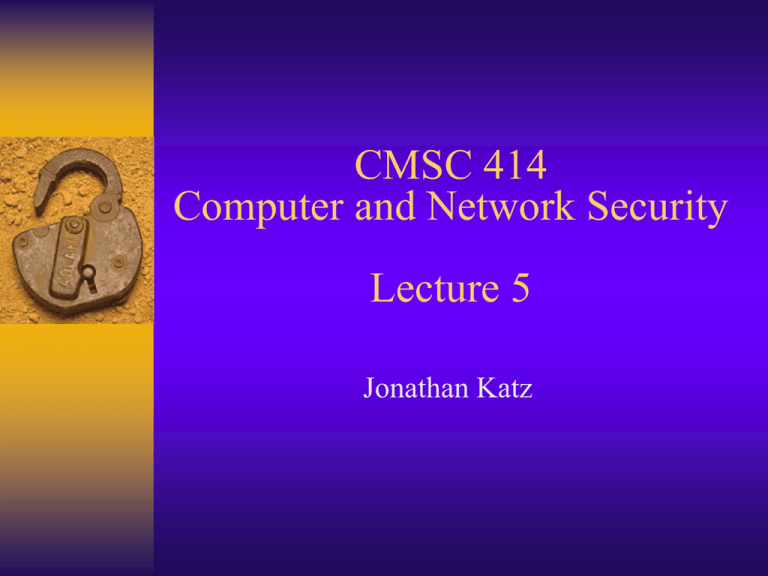
CMSC 414
Computer and Network Security
Lecture 5
Jonathan Katz
Message integrity
MAC functionality (review)
Bob
Alice
m, t
k
t = Mack(m)
k
Vrfyk(m’,t’) ??
•Shared key k
•Sender computes a tag t on the message m
using k
•Receiver verifies the message/tag pair using k
Defining security
Attack model:
– A random key k is chosen
– Attacker is allowed to obtain t1 = MACk(m1), …, tn =
MACk(mn) for any messages m1, …, mn of its choice
Attacker is successful if it outputs a forgery; i.e.,
(m, t) with:
– m ≠ mi for all i
– VrfyK(m, t) = 1
For any time-bounded adversary, the probability
of a successful attack should be small
A MAC for short messages
Let F be a block cipher with n-bit output
To authenticate m using key k, compute
t = Fk(m)
Vrfyk(m, t): output 1 iff t = Fk(m)
Why is this secure?
Authenticating longer messages?
Two widely used schemes (among several):
– CBC-MAC
– HMAC
CBC-MAC
Fix a message length Ln, where the block cipher
has n-bit block length
To compute MACk(m1, …, mL) do:
– Set t0 = 0n
– For i=1 to L, set ti := Fk(ti-1 mi)
– Output tL
To verify, re-compute and check…
[Note the similarities to (and differences from)
CBC mode encryption]
Security of CBC-MAC?
Secure for fixed-length messages
Insecure (as described) for variable-length
messages
– Must use secure variants of CBC-MAC if variablelength messages will be authenticated
HMAC
Can be viewed as a version of “hash-and-MAC”,
using collision-resistant hashing…
Hash functions
A (cryptographic) hash function H maps arbitrary
length inputs to a fixed-length output
Main goal is collision resistance:
– Hard to find distinct x, x’ such that H(x) = H(x’)
Other goals
– Second pre-image resistance: given x, hard to find
x’ ≠ x with H(x) = H(x’)
– “Random-looking output”: I.e., “acts like a random
oracle”
• Controversial; more later
Hash functions in practice
MD5
– 128-bit output
– Introduced in 1991…collision attacks found in 2004…several
extensions and improvements since then
– Still widely deployed(!)
SHA-1
– 160-bit output
– No collisions known, but theoretical attacks exist
SHA-2
– 256-/512-bit outputs
Competition to design new hash standard has just begun…
Hash-and-MAC
Hash message to short “digest”
MAC the digest
K
M
H
H(M)
MAC
HMAC uses essentially this idea
t
(Informal) sketch of security?
Say the adversary sees tags on m1, …, mt,, and
outputs a valid forgery on m {m1, …, mt}
Two possibilities:
– H(m) = H(mi) for some i – collision in H
– H(m) {H(m1), …, H(mt)} – forgery in the underlying
MAC for short messages
Encryption + integrity
In most settings, confidentiality and integrity are
both needed
– How to obtain both?
Use ‘encrypt-then-authenticate’
Other natural possibilities are problematic!
Toward public-key crypto…
Sharing keys?
Secure sharing of a key is necessary for private-
key crypto
– How do parties share a key in the first place?
One possibility is a secure physical channel
– E.g., in-person meeting
– Dedicated (un-tappable) phone line
– USB stick via courier service
Another possibility: key exchange protocols
– Parties can agree on a key over a public channel
– This is amazing! (And began a revolution in crypto…)
Diffie-Hellman key exchange
Before describing the protocol, a brief detour
through number theory…
– Modular arithmetic, Zp, Zp*
– Generators
– The discrete logarithm assumption

